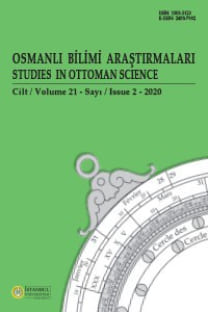Ahmed Muhtar Paşa’nın Tasarladığı Taşınabilir Güneşsaati ve Kullanımını Açıklayan ‘El Basîtesi Risalesi’
Either horizontal or vertical, sundials were of common use in the Ottoman Empire. Set on the south western façade of the mosques, the vertical sundials were especially used to determine the prayer times. Although the introduction of the mechanical clocks in the Empire in the 17th century threathened the popularity of sundials, their usage seem to have been partially kept.Despite the regular use of mechanical clocks, Ahmed Muhtar Pasha (Gazi, 1839-1919) published on portable sudials (el basîtesi) starting from 1867 on. An article on „fenn-i basîte‟, the technique of designing and constructing sundials, was serialized in the Mebahis-i İlmiye (Istanbul 1867-69), the first journal on mathematical sciences in Turkish. While he included chapters on sundials in his comprehensive work Riyazü’l-Muhtar (Bulaque, 1886) on Islamic astromical instruments, he published in 1867, a pamphlet accounting for the technical properties and usage of a portable sundial designed for a latitude of 41º north. A second edition of the pamphlet, made in 1909 in Istanbul witnesses the ongoing use of portable sundials in Turkey in early 20th century. Their usage, however, seems to be restricted. A research in the Kandilli Observatory Museum (Istanbul) revealed the existence of a portable sundial designed and crafted for the same lattitude. Information given by Ahmed Muhtar Pasha in his pamphlet, corresponds exactly with this portable sundial. This paper, while introducing the instrument and the pamphlet, will examine and account for the mathematical construction given by Ahmed Muhtar Pasha.The portable sundial, aims to determine the time (in hours and minutes) of the Sun rise, the Sun set, the prayer times, the lenghts of the day and the night in the zevâlî time. Moreover, it helps to adjust the clocks by measuring the height of the Sun and to determine the direction of Kibla. Ottoman sundials were designed so as to give time in „ezanic hour‟ (gurûbî, allaturca time). Turkey‟s move towards the adoption of universal time in late 19th century may have been a motivation for Ahmed Muhtar Pasha to design a sundial to determine the local apparent time
Anahtar Kelimeler:
Güneşsaati, basîte, Ahmed Muhtar Paşa, zaman ölçümü, astronomi tarihi
A portable sundial designed by Ahmed Muhtar Pasha and his treatise accounting for its usage
Either horizontal or vertical, sundials were of common use in the Ottoman Empire. Set on the south western façade of the mosques, the vertical sundials were especially used to determine the prayer times. Although the introduction of the mechanical clocks in the Empire in the 17th century threathened the popularity of sundials, their usage seem to have been partially kept.Despite the regular use of mechanical clocks, Ahmed Muhtar Pasha (Gazi, 1839-1919) published on portable sudials (el basîtesi) starting from 1867 on. An article on „fenn-i basîte‟, the technique of designing and constructing sundials, was serialized in the Mebahis-i İlmiye (Istanbul 1867-69), the first journal on mathematical sciences in Turkish. While he included chapters on sundials in his comprehensive work Riyazü’l-Muhtar (Bulaque, 1886) on Islamic astromical instruments, he published in 1867, a pamphlet accounting for the technical properties and usage of a portable sundial designed for a latitude of 41º north. A second edition of the pamphlet, made in 1909 in Istanbul witnesses the ongoing use of portable sundials in Turkey in early 20th century. Their usage, however, seems to be restricted. A research in the Kandilli Observatory Museum (Istanbul) revealed the existence of a portable sundial designed and crafted for the same lattitude. Information given by Ahmed Muhtar Pasha in his pamphlet, corresponds exactly with this portable sundial. This paper, while introducing the instrument and the pamphlet, will examine and account for the mathematical construction given by Ahmed Muhtar Pasha.The portable sundial, aims to determine the time (in hours and minutes) of the Sun rise, the Sun set, the prayer times, the lenghts of the day and the night in the zevâlî time. Moreover, it helps to adjust the clocks by measuring the height of the Sun and to determine the direction of Kibla. Ottoman sundials were designed so as to give time in „ezanic hour‟ (gurûbî, allaturca time). Turkey‟s move towards the adoption of universal time in late 19th century may have been a motivation for Ahmed Muhtar Pasha to design a sundial to determine the local apparent time
Keywords:
sundial, basita, Ahmed Muhtar Pasha, timekeeping, history of astronomy,
___
- -
- ISSN: 1303-3123
- Yayın Aralığı: Yılda 2 Sayı
- Başlangıç: 1995
- Yayıncı: İstanbul Üniversitesi Edebiyat Fakültesi
Sayıdaki Diğer Makaleler
Galiçya Cephesi’nde Osmanlı Birlikleri ve Sağlık Hizmetleri (1916-1917)
Nevizade Ataî'nin Hadaikü'l-hakaik'indenTakiyüddin'in biyografisi
Joseph Bornmüller’in (1862-1948) Anadolu’da Bitki Toplama Gezileri
Takiyüddin’in Pera’daki Gözlemevi
Nevizade Ataî’nin Hadaikü’l-Hakaik’inden Takiyyüddin’in Biyografisi
Paul-Louıs Sımond Ve Bakteriyolojihane-İ Osmani’nin Çemberlitaş’ta Açılışı (21 Eylül 1911)
Galiçya cephesi'nde Osmanlı birlikleri ve sağlık hizmetleri (1916-1917)
